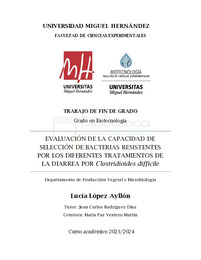Título :
Evaluación de la capacidad de selección de bacterias resistentes por los diferentes tratamientos de la diarrea por Clostridioides difficile |
Autor :
López Ayllón, Lucía |
Tutor:
Rodríguez Díaz, Juan Carlos
Ventero, Maria Paz  |
Editor :
Universidad Miguel Hernández de Elche |
Departamento:
Departamentos de la UMH::Producción Vegetal y Microbiología |
Fecha de publicación:
2024-06 |
URI :
https://hdl.handle.net/11000/33165 |
Resumen :
La infección por clostridioides difficile (ICD) está muy relacionada con la composición del microbioma del paciente. La vancomicina y la fidaxomicina son los antibióticos más comúnmente utilizados para el tratamiento de esta infección, aunque está demostrado que la fidaxomicina es menos lesiva sobre el microbioma del paciente que la vancomicina. Con objeto de caracterizar este fenómeno, se analizó la influencia de estos dos tratamientos sobre la presencia de bacterias resistentes en el microbioma de los pacientes. para ello, se analizaron muestras de heces pretratamiento y postratamiento de 88 pacientes diagnosticados de ICD. Estas muestras se sembraron en placas selectivas para identificar bacterias resistentes a diferentes betalactámicos, colistina, linezolid o vancomicina y levaduras resistentes a fluconazol. Las colonias se identificaron mediante MALDI-TOF y se llevaron a cabo confirmaciones fenotípicas de su resistencia. Se obtuvieron diez aislamientos de E. coli productora de BLEE y un aislamiento de cada una de las siguientes especies: K. pneumoniae y P. aeruginosa productoras de carbapenemasas, K. oxytoca resistente a colistina y S. epidermidis resistente a linezolid. Como conclusión, no se ha podido validar en nuestro medio que la vancomicina sea un fármaco con mayor capacidad de selección de microorganismos resistentes que la fidaxomicina, puesto que no hubo suficientes aislamientos como para observar ninguna relación entre este antibiótico y la selección de patógenos resistentes.
Clostridioides difficile infection (CDI) is strongly related to the composition of the patient's microbiome. Vancomycin and fidaxomicin are the most used antibiotics for the treatment of this infection, although fidaxomicin has been shown to be less damaging to the patient's microbiome than vancomycin. To characterise this phenomenon, the influence of these two treatments on the presence of resistant bacteria in the microbiome of patients was analysed. For this purpose, pre-treatment and posttreatment stool samples from 88 patients diagnosed with CDI were analysed. These samples were inoculated on selective plates to identify bacteria resistant to different beta-lactams, colistin, linezolid or vancomycin and fluconazole-resistant yeasts. Colonies were identified by MALDI-TOF, and phenotypic confirma on of resistance was performed. Ten isolates of ESBL-producing E. coli and one isolate of each of the following species were obtained: carbapenemase-producing K. pneumoniae and P. aeruginosa, colistin-resistant K. oxytoca and linezolid-resistant S. epidermidis. All in all, it has not been possible to validate in our setting that vancomycin is a drug with a greater capacity to select resistant microorganisms than fidaxomicin since there were not enough isolates to observe any relationship between vancomycin and the selection of antibiotic-resistant pathogens.
|
Palabras clave/Materias:
microbioma
ICD
fidaxomicina
vancomicina
cultivo
resistencia
microbiome
fidaxomicin
vancomycin
culture
resistance |
Área de conocimiento :
CDU: Ciencias puras y naturales: Biología |
Tipo de documento :
info:eu-repo/semantics/bachelorThesis |
Derechos de acceso:
info:eu-repo/semantics/openAccess |
Aparece en las colecciones:
TFG - Biotecnología
|
 La licencia se describe como: Atribución-NonComercial-NoDerivada 4.0 Internacional.
La licencia se describe como: Atribución-NonComercial-NoDerivada 4.0 Internacional.
.png)
